Comprehensive Business Report: Purpose, Types, and Units Analysis
VerifiedAdded on 2022/12/30
|6
|1135
|24
Report
AI Summary
This report provides a comprehensive overview of business concepts, including the purpose of business, which is to maximize profit and provide value to customers. It categorizes businesses into private, public, and voluntary types, detailing the characteristics and goals of each. The report explores the responsibilities of key functional units such as HR, marketing, and finance, emphasizing their interrelationships. It also discusses organizational culture, its types (power, role, task), and the influence of management styles. Furthermore, the report delves into the role of financial management, including liabilities of different business structures (sole trader vs. public limited company) and essential company documentation such as profit and loss accounts, balance sheets, and cash flow statements. The conclusion summarizes the vital role of functional units in achieving company objectives and reinforces the importance of understanding different business types.

Report
1
1
Paraphrase This Document
Need a fresh take? Get an instant paraphrase of this document with our AI Paraphraser
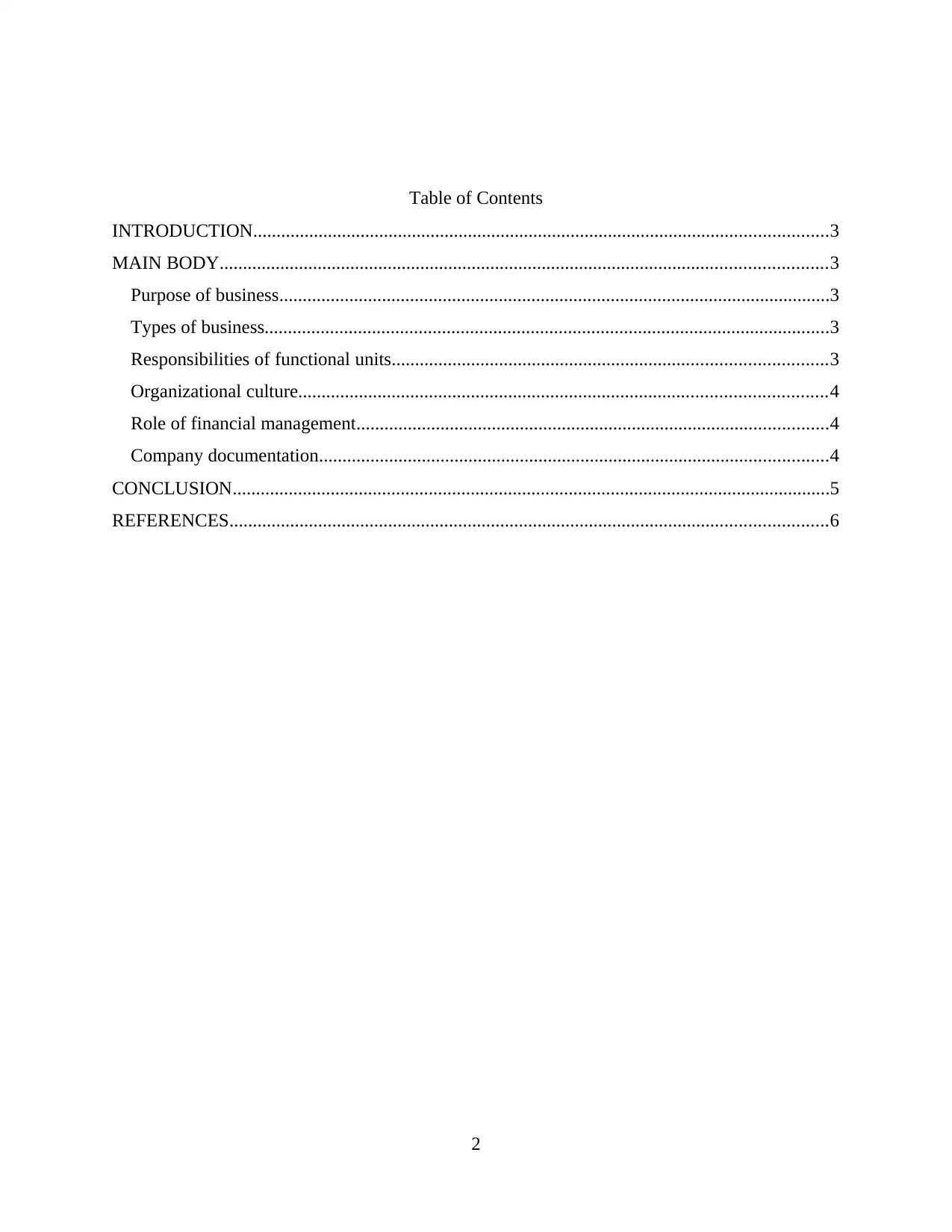
Table of Contents
INTRODUCTION...........................................................................................................................3
MAIN BODY..................................................................................................................................3
Purpose of business......................................................................................................................3
Types of business.........................................................................................................................3
Responsibilities of functional units.............................................................................................3
Organizational culture.................................................................................................................4
Role of financial management.....................................................................................................4
Company documentation.............................................................................................................4
CONCLUSION................................................................................................................................5
REFERENCES................................................................................................................................6
2
INTRODUCTION...........................................................................................................................3
MAIN BODY..................................................................................................................................3
Purpose of business......................................................................................................................3
Types of business.........................................................................................................................3
Responsibilities of functional units.............................................................................................3
Organizational culture.................................................................................................................4
Role of financial management.....................................................................................................4
Company documentation.............................................................................................................4
CONCLUSION................................................................................................................................5
REFERENCES................................................................................................................................6
2
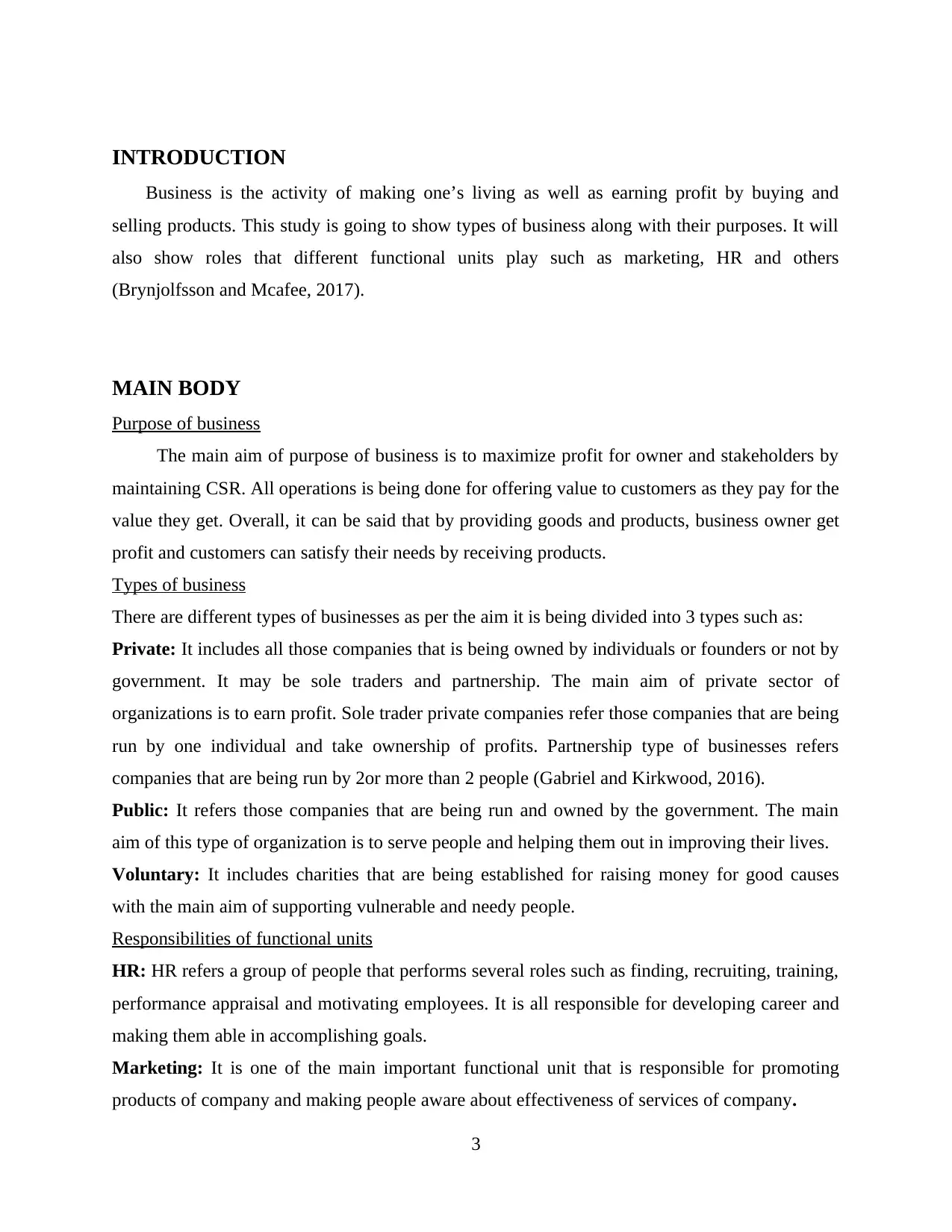
INTRODUCTION
Business is the activity of making one’s living as well as earning profit by buying and
selling products. This study is going to show types of business along with their purposes. It will
also show roles that different functional units play such as marketing, HR and others
(Brynjolfsson and Mcafee, 2017).
MAIN BODY
Purpose of business
The main aim of purpose of business is to maximize profit for owner and stakeholders by
maintaining CSR. All operations is being done for offering value to customers as they pay for the
value they get. Overall, it can be said that by providing goods and products, business owner get
profit and customers can satisfy their needs by receiving products.
Types of business
There are different types of businesses as per the aim it is being divided into 3 types such as:
Private: It includes all those companies that is being owned by individuals or founders or not by
government. It may be sole traders and partnership. The main aim of private sector of
organizations is to earn profit. Sole trader private companies refer those companies that are being
run by one individual and take ownership of profits. Partnership type of businesses refers
companies that are being run by 2or more than 2 people (Gabriel and Kirkwood, 2016).
Public: It refers those companies that are being run and owned by the government. The main
aim of this type of organization is to serve people and helping them out in improving their lives.
Voluntary: It includes charities that are being established for raising money for good causes
with the main aim of supporting vulnerable and needy people.
Responsibilities of functional units
HR: HR refers a group of people that performs several roles such as finding, recruiting, training,
performance appraisal and motivating employees. It is all responsible for developing career and
making them able in accomplishing goals.
Marketing: It is one of the main important functional unit that is responsible for promoting
products of company and making people aware about effectiveness of services of company.
3
Business is the activity of making one’s living as well as earning profit by buying and
selling products. This study is going to show types of business along with their purposes. It will
also show roles that different functional units play such as marketing, HR and others
(Brynjolfsson and Mcafee, 2017).
MAIN BODY
Purpose of business
The main aim of purpose of business is to maximize profit for owner and stakeholders by
maintaining CSR. All operations is being done for offering value to customers as they pay for the
value they get. Overall, it can be said that by providing goods and products, business owner get
profit and customers can satisfy their needs by receiving products.
Types of business
There are different types of businesses as per the aim it is being divided into 3 types such as:
Private: It includes all those companies that is being owned by individuals or founders or not by
government. It may be sole traders and partnership. The main aim of private sector of
organizations is to earn profit. Sole trader private companies refer those companies that are being
run by one individual and take ownership of profits. Partnership type of businesses refers
companies that are being run by 2or more than 2 people (Gabriel and Kirkwood, 2016).
Public: It refers those companies that are being run and owned by the government. The main
aim of this type of organization is to serve people and helping them out in improving their lives.
Voluntary: It includes charities that are being established for raising money for good causes
with the main aim of supporting vulnerable and needy people.
Responsibilities of functional units
HR: HR refers a group of people that performs several roles such as finding, recruiting, training,
performance appraisal and motivating employees. It is all responsible for developing career and
making them able in accomplishing goals.
Marketing: It is one of the main important functional unit that is responsible for promoting
products of company and making people aware about effectiveness of services of company.
3
⊘ This is a preview!⊘
Do you want full access?
Subscribe today to unlock all pages.

Trusted by 1+ million students worldwide
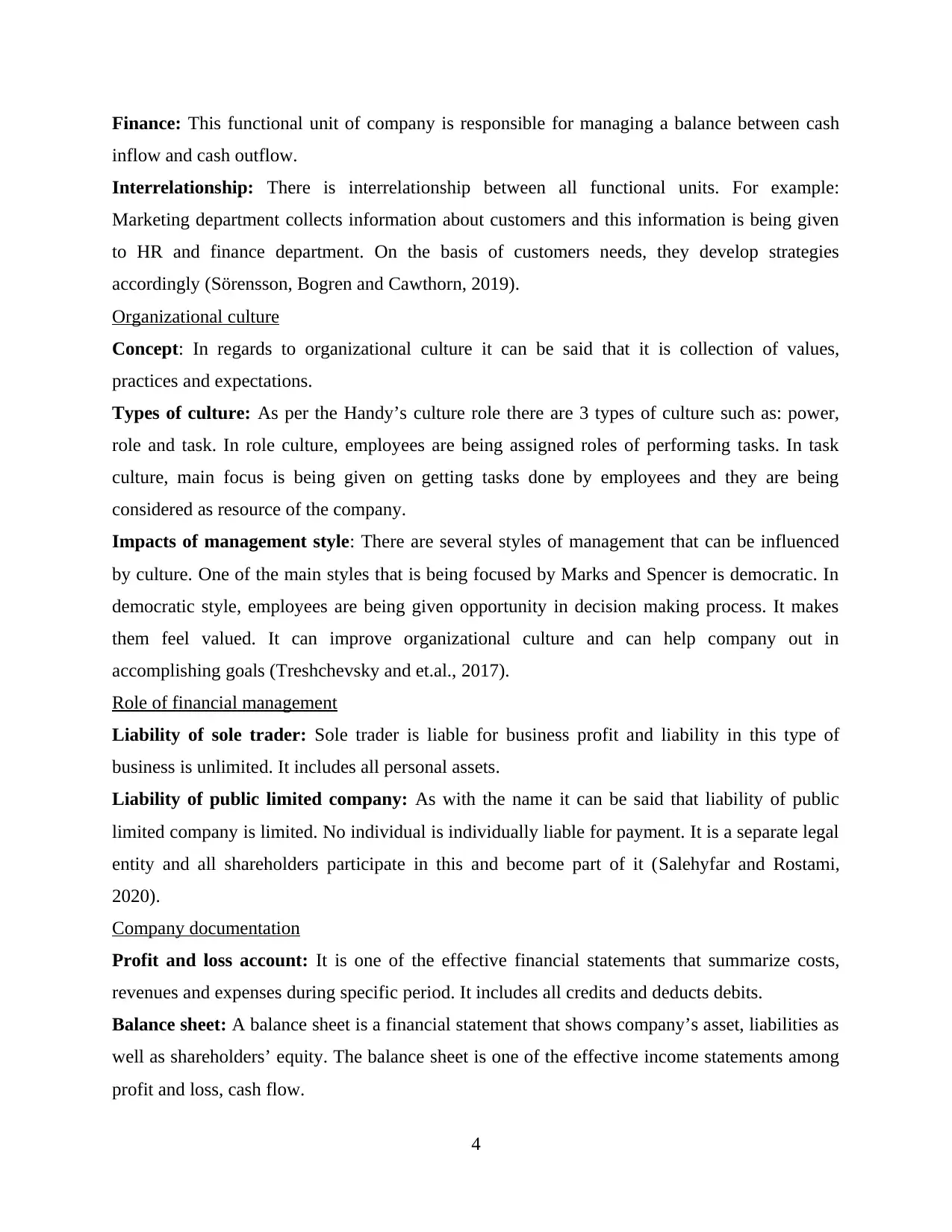
Finance: This functional unit of company is responsible for managing a balance between cash
inflow and cash outflow.
Interrelationship: There is interrelationship between all functional units. For example:
Marketing department collects information about customers and this information is being given
to HR and finance department. On the basis of customers needs, they develop strategies
accordingly (Sörensson, Bogren and Cawthorn, 2019).
Organizational culture
Concept: In regards to organizational culture it can be said that it is collection of values,
practices and expectations.
Types of culture: As per the Handy’s culture role there are 3 types of culture such as: power,
role and task. In role culture, employees are being assigned roles of performing tasks. In task
culture, main focus is being given on getting tasks done by employees and they are being
considered as resource of the company.
Impacts of management style: There are several styles of management that can be influenced
by culture. One of the main styles that is being focused by Marks and Spencer is democratic. In
democratic style, employees are being given opportunity in decision making process. It makes
them feel valued. It can improve organizational culture and can help company out in
accomplishing goals (Treshchevsky and et.al., 2017).
Role of financial management
Liability of sole trader: Sole trader is liable for business profit and liability in this type of
business is unlimited. It includes all personal assets.
Liability of public limited company: As with the name it can be said that liability of public
limited company is limited. No individual is individually liable for payment. It is a separate legal
entity and all shareholders participate in this and become part of it (Salehyfar and Rostami,
2020).
Company documentation
Profit and loss account: It is one of the effective financial statements that summarize costs,
revenues and expenses during specific period. It includes all credits and deducts debits.
Balance sheet: A balance sheet is a financial statement that shows company’s asset, liabilities as
well as shareholders’ equity. The balance sheet is one of the effective income statements among
profit and loss, cash flow.
4
inflow and cash outflow.
Interrelationship: There is interrelationship between all functional units. For example:
Marketing department collects information about customers and this information is being given
to HR and finance department. On the basis of customers needs, they develop strategies
accordingly (Sörensson, Bogren and Cawthorn, 2019).
Organizational culture
Concept: In regards to organizational culture it can be said that it is collection of values,
practices and expectations.
Types of culture: As per the Handy’s culture role there are 3 types of culture such as: power,
role and task. In role culture, employees are being assigned roles of performing tasks. In task
culture, main focus is being given on getting tasks done by employees and they are being
considered as resource of the company.
Impacts of management style: There are several styles of management that can be influenced
by culture. One of the main styles that is being focused by Marks and Spencer is democratic. In
democratic style, employees are being given opportunity in decision making process. It makes
them feel valued. It can improve organizational culture and can help company out in
accomplishing goals (Treshchevsky and et.al., 2017).
Role of financial management
Liability of sole trader: Sole trader is liable for business profit and liability in this type of
business is unlimited. It includes all personal assets.
Liability of public limited company: As with the name it can be said that liability of public
limited company is limited. No individual is individually liable for payment. It is a separate legal
entity and all shareholders participate in this and become part of it (Salehyfar and Rostami,
2020).
Company documentation
Profit and loss account: It is one of the effective financial statements that summarize costs,
revenues and expenses during specific period. It includes all credits and deducts debits.
Balance sheet: A balance sheet is a financial statement that shows company’s asset, liabilities as
well as shareholders’ equity. The balance sheet is one of the effective income statements among
profit and loss, cash flow.
4
Paraphrase This Document
Need a fresh take? Get an instant paraphrase of this document with our AI Paraphraser
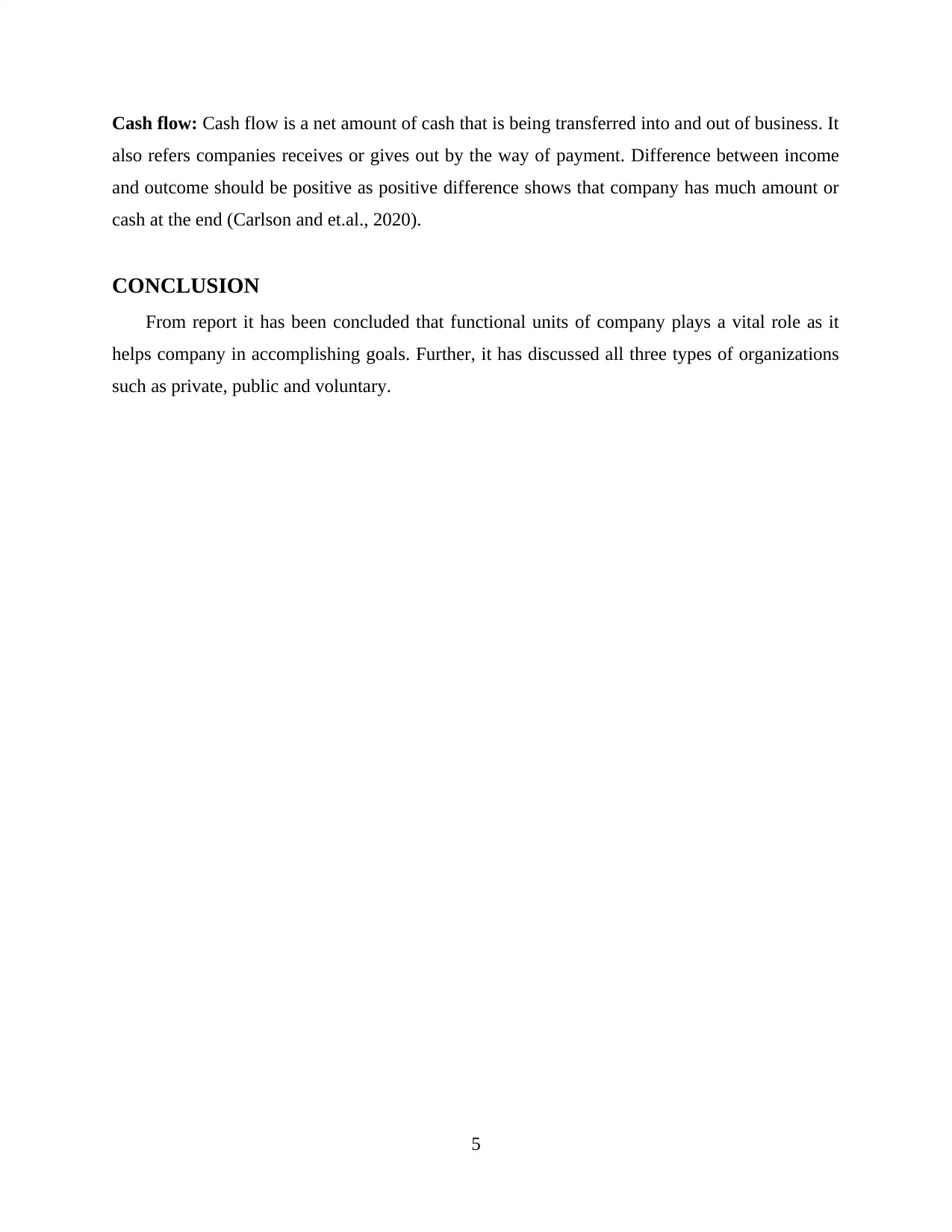
Cash flow: Cash flow is a net amount of cash that is being transferred into and out of business. It
also refers companies receives or gives out by the way of payment. Difference between income
and outcome should be positive as positive difference shows that company has much amount or
cash at the end (Carlson and et.al., 2020).
CONCLUSION
From report it has been concluded that functional units of company plays a vital role as it
helps company in accomplishing goals. Further, it has discussed all three types of organizations
such as private, public and voluntary.
5
also refers companies receives or gives out by the way of payment. Difference between income
and outcome should be positive as positive difference shows that company has much amount or
cash at the end (Carlson and et.al., 2020).
CONCLUSION
From report it has been concluded that functional units of company plays a vital role as it
helps company in accomplishing goals. Further, it has discussed all three types of organizations
such as private, public and voluntary.
5
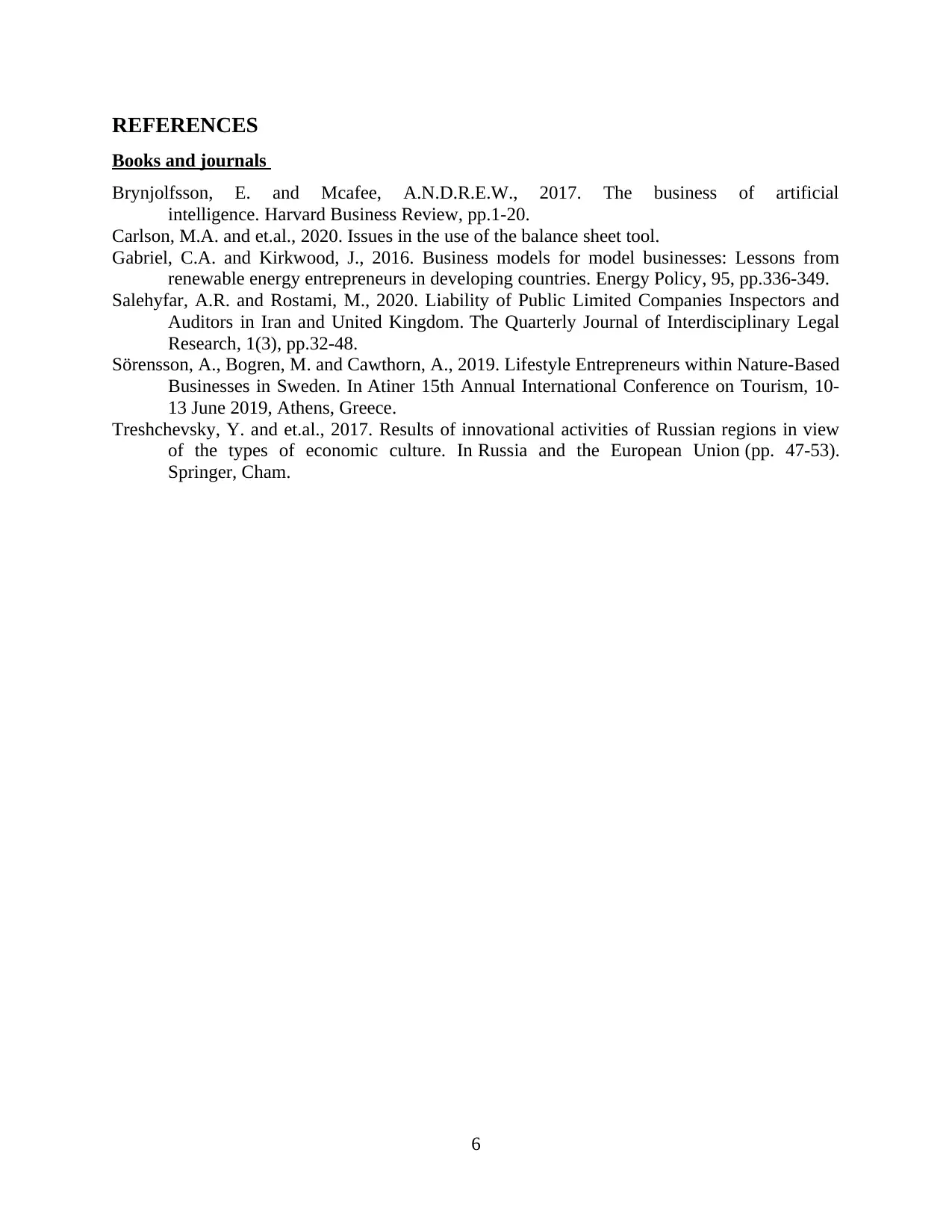
REFERENCES
Books and journals
Brynjolfsson, E. and Mcafee, A.N.D.R.E.W., 2017. The business of artificial
intelligence. Harvard Business Review, pp.1-20.
Carlson, M.A. and et.al., 2020. Issues in the use of the balance sheet tool.
Gabriel, C.A. and Kirkwood, J., 2016. Business models for model businesses: Lessons from
renewable energy entrepreneurs in developing countries. Energy Policy, 95, pp.336-349.
Salehyfar, A.R. and Rostami, M., 2020. Liability of Public Limited Companies Inspectors and
Auditors in Iran and United Kingdom. The Quarterly Journal of Interdisciplinary Legal
Research, 1(3), pp.32-48.
Sörensson, A., Bogren, M. and Cawthorn, A., 2019. Lifestyle Entrepreneurs within Nature-Based
Businesses in Sweden. In Atiner 15th Annual International Conference on Tourism, 10-
13 June 2019, Athens, Greece.
Treshchevsky, Y. and et.al., 2017. Results of innovational activities of Russian regions in view
of the types of economic culture. In Russia and the European Union (pp. 47-53).
Springer, Cham.
6
Books and journals
Brynjolfsson, E. and Mcafee, A.N.D.R.E.W., 2017. The business of artificial
intelligence. Harvard Business Review, pp.1-20.
Carlson, M.A. and et.al., 2020. Issues in the use of the balance sheet tool.
Gabriel, C.A. and Kirkwood, J., 2016. Business models for model businesses: Lessons from
renewable energy entrepreneurs in developing countries. Energy Policy, 95, pp.336-349.
Salehyfar, A.R. and Rostami, M., 2020. Liability of Public Limited Companies Inspectors and
Auditors in Iran and United Kingdom. The Quarterly Journal of Interdisciplinary Legal
Research, 1(3), pp.32-48.
Sörensson, A., Bogren, M. and Cawthorn, A., 2019. Lifestyle Entrepreneurs within Nature-Based
Businesses in Sweden. In Atiner 15th Annual International Conference on Tourism, 10-
13 June 2019, Athens, Greece.
Treshchevsky, Y. and et.al., 2017. Results of innovational activities of Russian regions in view
of the types of economic culture. In Russia and the European Union (pp. 47-53).
Springer, Cham.
6
⊘ This is a preview!⊘
Do you want full access?
Subscribe today to unlock all pages.

Trusted by 1+ million students worldwide
1 out of 6
Related Documents
Your All-in-One AI-Powered Toolkit for Academic Success.
+13062052269
info@desklib.com
Available 24*7 on WhatsApp / Email
![[object Object]](/_next/static/media/star-bottom.7253800d.svg)
Unlock your academic potential
Copyright © 2020–2025 A2Z Services. All Rights Reserved. Developed and managed by ZUCOL.





